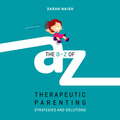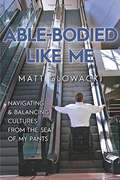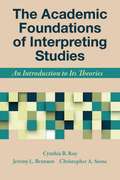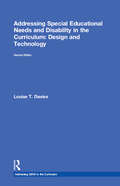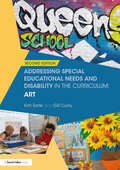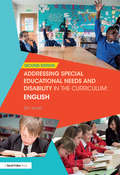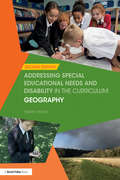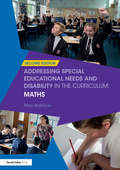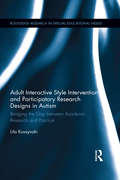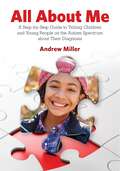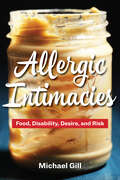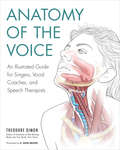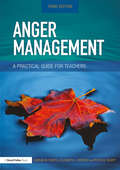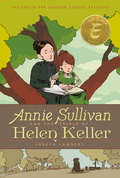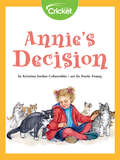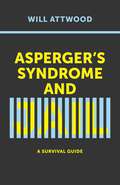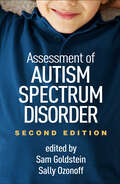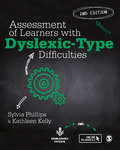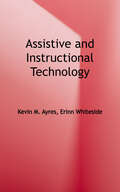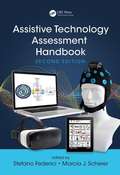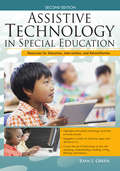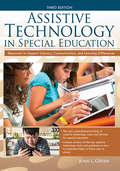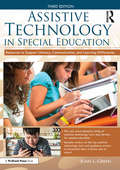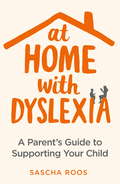- Table View
- List View
The A-Z of Therapeutic Parenting: Strategies and Solutions (Therapeutic Parenting Books)
by Sarah NaishThe complete guide to therapeutic parenting, with an A-Z of applied advice for 60 common issuesTherapeutic parenting is a deeply nurturing parenting style, and is especially effective for children with attachment difficulties, or who experienced childhood trauma. This book provides everything you need to know in order to be able to effectively therapeutically parent.Providing a model of intervention, The A-Z of Therapeutic Parenting gives parents or caregivers an easy to follow process to use when responding to issues with their children. The following A-Z covers 60 common problems parents face, from acting aggressively to difficulties with sleep, with advice on what might trigger these issues, and how to respond.Easy to navigate and written in a straightforward style, this book is a 'must have' for all therapeutic parents.(P) 2019 Hodder & Stoughton Ltd
Able-bodied Like Me: Navigating And Balancing Cultures From The Seat Of My Pants
by Matt GlowackiIn his insightful new memoir, Able-Bodied like Me, Matt Glowacki, civility speaker and author, chronicles the changing attitudes in our society—and in himself—about what it means to be disabled. <P><P>In the 1970s, when Glowacki was born, disabilities were still considered something to hide. Despite being born without legs, Glowacki pushed back against this narrative. He didn’t consider himself disabled and thought the term imposed unneeded limitations. He also balked at the tone-deaf remarks of others. He didn’t want to be an “inspiration” to people without impairments or a convenient way for others to signal their own virtue. Glowacki wanted to simply live his life, and he clearly explains how harmful certain remarks and actions can be for people in the disabled community. <P><P>In his memoir, Glowacki lists eighteen points to ponder as you reflect on your own assumptions and actions. Glowacki also examines his own changing beliefs about the term “disability,” as well as society’s shifting perspective. <P><P>As Glowacki shares the challenges he and others face in their everyday lives, he also offers suggestions about how to foster an environment of mutual respect and understanding. Glowacki certainly doesn’t want your pity. He just wants you to listen.
The Academic Foundations of Interpreting Studies: An Introduction to Its Theories
by Cynthia B. Roy Jeremy L. Brunson Christopher A. StoneThe Academic Foundations of Interpreting Studies is the first introductory course book that explores the theoretical foundations used in sign language interpreting studies. Authors Roy, Brunson, and Stone examine the disciplines whose theoretical frameworks and methodologies have influenced the academic study of interpreting. With this text, explanations for how interpreted events occur, how interpreted products are created, and how the interpreting process is studied can be framed within a variety of theoretical perspectives, forming a foundation for the emerging transdiscipline of Interpreting Studies. As sign language interpreting has emerged and evolved in the last 20 years as an academic field of study, the scope of learning has broadened to include fields beyond the language and culture of deaf people. This text surveys six disciplines that have informed the study of sign language interpreting: history, translation, linguistics, sociology, social psychology, and cognitive psychology, along with their major ideas, principal scholars, and ways of viewing human interaction. Each chapter includes clear learning goals, definitions, discussion questions, and images to aid understanding. The Academic Foundations of Interpreting Studies is required reading for upper-level undergraduate or first-year graduate students in interpreting, Deaf studies, and sign language programs.
Addressing Special Educational Needs and Disability in the Curriculum: Design And Technology (Addressing SEND in the Curriculum)
by Louise T. DaviesThe SEND Code of Practice (2015) reinforced the requirement that all teachers must meet the needs of all learners. This topical book provides practical, tried-and-tested strategies and resources that will support teachers in making design and technology lessons accessible and interesting for all pupils, including those with special educational needs. The author draws on a wealth of experience to share her understanding of special educational needs and disabilities and show how the design and technology teacher can reduce or remove any barriers to learning. Offering strategies that are specific to the context of design and technology teaching, this book will enable teachers to: better identify a student’s particular learning requirements; set inclusive design and making assignments which allow all students to participate and succeed; build students’ confidence in using a range of materials and tools; assist with design tasks where pupils take ownership of their work and learning; adapt the classroom environment to meet the needs of pupils; create a mutually supportive classroom which maximises learning opportunities. An invaluable tool for continuing professional development, this text will be essential for design and technology teachers (and their teaching assistants) seeking to include and motivate all pupils in their lessons, regardless of their individual needs. This book will also be of interest to secondary SENCOs, senior management teams and ITT providers. In addition to free online resources, a range of appendices provide design and technology teachers with a variety of pro forma and activity sheets to support effective teaching. This is an essential tool for design and technology teachers and teaching assistants, and will help to deliver successful, inclusive lessons for all pupils.
Addressing Special Educational Needs and Disability in the Curriculum: Art (Addressing SEND in the Curriculum)
by Kim Earle Gill CurryThe SEND Code of Practice (2015) reinforced the requirement that all teachers must meet the needs of all learners. This topical book provides practical, tried and tested strategies and resources that will support teachers in making art lessons accessible and interesting for all pupils, including those with special needs. The authors draw on a wealth of experience to share their understanding of special educational needs and disabilities and show how the art teacher can reduce or remove any barriers to learning. Offering strategies that are specific to the context of art teaching, this book will enable teachers to: develop students’ understanding, appreciation and enjoyment of art and design; advance students’ sense of enquiry about visual and tactile experiences; help pupils to realise their creative intentions, through the development of technical competence and manipulative skills; provide opportunities for personal and imaginative enquiry; sample a variety of art and design projects to use in their own lessons; plan the classroom layout and display to enhance learning; successfully train, and fully use the support of, their teaching assistants. An invaluable tool for continuing professional development, this text will be essential for secondary art teachers (and their teaching assistants) seeking guidance specific to teaching art to all pupils, regardless of their individual needs. The book will also be of interest to secondary SENCOs, senior management teams and ITT providers. Full of practical ideas and inspiration, and supported by free online resources, this is an essential tool for art teachers and teaching assistants and will help to deliver successful, inclusive lessons for all pupils.
Addressing Special Educational Needs and Disability in the Curriculum: English (Addressing SEND in the Curriculum)
by Tim HurstThis book provides practical strategies and resources that have been proven effective in teaching English to pupils of all abilities, making English accessible, challenging and exciting. The author outlines important key principles that should underpin teaching and learning so that all pupils, including those with special educational needs, can enjoy the subject and make outstanding progress. The ideas and guidance draw on a wealth of experience, providing classroom activities and free online resources, which can be combined with different teaching approaches. A range of appendices provides teachers with real-life case studies and examples and templates for supporting pupils with SEND. Offering strategies that are specific to the context of English teaching, this book will enable teachers and their teaching assistants to: develop pupils’ understanding by engaging multi-sensory approaches; ensure all pupils are able to participate fully in lessons and achieve success; design and use individual plans for pupils with SEND; assess and adapt content and resources when differentiating materials for pupils with a wide range of learning needs; use formative assessments to measure learning and inform planning. An invaluable tool for whole-school continuing professional development, this fully revised text will be essential for teachers and their teaching assistants seeking guidance specific to teaching English to all pupils, regardless of their individual needs. This book will also be of interest to SENDCOs, learning support units and senior management teams as well as to teacher-training professionals.
Addressing Special Educational Needs and Disability in the Curriculum: Geography (Addressing SEND in the Curriculum)
by Helen HarrisThe SEND Code of Practice (2015) reinforced the requirement that all teachers must meet the needs of all learners. This topical book provides practical, tried and tested strategies and resources that will support teachers in making geography lessons accessible and interesting for all pupils, including those with special needs. The author draws on a wealth of experience to share her understanding of individual needs and show how the geography teacher can reduce or remove any barriers to learning. Offering strategies that are specific to the context of geography teaching, this book will enable teachers to: ensure all pupils are able to participate in every lesson; provide inclusive fieldwork opportunities that take into consideration the needs of all pupils; use formative assessments to measure learning and inform planning; plan the classroom layout and display to enhance learning; successfully use the support of their teaching assistants. An invaluable tool for continuing professional development, this text will be essential for middle school and secondary geography teachers (and their teaching assistants) who are committed to creating an inclusive learning environment for all pupils, regardless of their individual needs. The book will also be of interest to SENCOs and inclusion managers, curriculum co-ordinators, senior management teams and ITT providers. Full of practical ideas and inspiration, and supported by free online resources, this is an essential tool for geography teachers and teaching assistants who want to deliver successful, inclusive lessons for all pupils.
Addressing Special Educational Needs and Disability in the Curriculum: Maths (Addressing SEND in the Curriculum)
by Max WallaceThe SEND Code of Practice (2015) reinforced the requirement that all teachers must meet the needs of all learners. This topical book provides practical, tried and tested strategies and resources that will support teachers in making maths lessons accessible and interesting for all pupils, including those with special needs. The author draws on a wealth of experience to share his understanding of special educational needs and disabilities and show how the maths teacher can reduce or remove any barriers to learning. Offering strategies that are specific to the context of maths teaching, this book will enable teachers to: adopt a ‘problem solving’ approach to ensure students use and apply mathematics at all times during their learning develop students’ understanding of mathematical ideas structure lessons to empower and actively engage students create a mutually supportive classroom which maximises learning opportunities plan the classroom layout and display to enhance learning, for example displaying number lines, vocabulary lists and pupils’ work successfully train and fully use the support of their teaching assistants. An invaluable tool for continuing professional development, this text will be essential for secondary maths teachers (and their teaching assistants) seeking guidance specific to teaching maths to all pupils, regardless of their individual needs. This book will also be of interest to secondary SENCOs, senior management teams and ITT providers. In addition to free online resources, a range of appendices provide maths teachers with a variety of pro forma and activity sheets to support effective teaching. This is an essential tool for maths teachers and teaching assistants, and will help to deliver successful, inclusive lessons for all pupils.
Adult Interactive Style Intervention and Participatory Research Designs in Autism: Bridging the Gap between Academic Research and Practice (Routledge Research in Special Educational Needs)
by Lila KossyvakiRegardless of their cognitive and linguistic abilities, people with autism can often find it difficult to develop basic communicative skills that are necessary to gain full control over their environment and maintain their independence. Building on the author’s own cutting-edge research, Adult Interactive Style Intervention and Participatory Research Designs in Autism examines the impact that the interactive style of neurotypical individuals could have on the spontaneous communication of children with autism. This book provides clear and detailed guidance on how to conduct research into autism in real-world settings such as schools and homes. Kossyvaki critically evaluates a wealth of relevant case studies and focuses on a number of methodological issues that researchers are likely to face when carrying out research of this complex nature. The author walks the reader through present literature on the importance of spontaneous communication and the atypical way that this tends to develop in autism, before bringing the results of her own research to bear on the question of how the interactive styles of neurotypical individuals can impact on the spontaneous communication of people with autism. Adult Interactive Style Intervention and Participatory Research Designs in Autism is essential reading for academics, researchers, and postgraduate students in the fields of special educational needs, inclusion, autism, research methods, and educational and clinical psychology.
All About Me: A Step-by-Step Guide to Telling Children and Young People on the Autism Spectrum about Their Diagnosis
by Andrew MillerBased on direct work with over 250 individual children, Andrew Miller wrote this book in order to provide parents and professionals with information, tools and guidance to help introduce children to autism in the absence of specialist support. This in-depth guide describes the practicalities of disclosure, including when to tell, who should do it and what they need to know beforehand with strategies to tailor your approach as every child's experience will be different. Step-by-step instructions detail how to deliver the programme and produce with a child a personalised booklet containing information about their personal attributes and their autism. These booklets and follow-up material help make disclosure a positive and constructive experience for everyone. Accompanying material can be downloaded online including questionnaires, examples of children's booklets and flexible templates.
Allergic Intimacies: Food, Disability, Desire, and Risk
by Michael GillThe first book to explore food allergies in the United States from the perspective of disability and raceAre food allergies disabilities? What structures and systems ensure the survival of some with food allergies and not others? Allergic Intimacies is a groundbreaking critical engagement with food allergies in their cultural representations, advocacy, law, and stories about personal experiences from a disability studies perspective. Author Michael Gill questions the predominantly individualized medical approaches to food allergies, pointing out that these approaches are particularly problematic where allergy testing and treatments are expensive, inconsistent, and inaccessible for many people of color.This thought-provoking book explores the multiple meanings of food allergies and eating in the United States, demonstrating how much more is at stake than we realize, at a critical time when food allergies are on the rise: An estimated 32 million Americans, including one in thirteen children, have food allergies. Diagnoses of food allergies in children have increased by 50 percent since 1997. Yet as the author makes clear, the whiteness of the food allergy community and single-identity disability theory is inherently limiting and insufficient to address the complex choices that those with food allergies make. Gill argues that racism and ableism create unique precarity for disabled people of color that food allergic communities are only beginning to address. There is a huge disparity in access to testing and treatment, with African American and Latinx children having higher risk of adverse outcomes than white children, including more rates of anaphylaxis. Food allergy professionals have a responsibility to move beyond individualized approaches to more robust coalitional efforts grounded in disability and racial justice to undo these patterns of exclusion.Allergic Intimacies celebrates the various creative ways food allergic communities are challenging historical and current practice of exclusion, while identifying the depth of work that still needs to be done to shift focus from a white allergic experience toward a more representative understanding of the racial, ethnic, religious, and economic diversity of those in the United States. Gill’s book is a discerning and vital exploration of the key debates about risks, dangers, safety, representations, and political concerns affecting the lives of individuals with food allergies.
Anatomy of the Voice: An Illustrated Guide for Singers, Vocal Coaches, and Speech Therapists
by Theodore Dimon G. David BrownThe first comprehensive, fully-illustrated approach to the voice that explains the anatomy and mechanics in detailed yet down-to-earth terms, for voice users and professionals of all kindsThis book is the first to explain, in clear and concise language, the anatomy and mechanics of the mysterious and complex bodily system we call the voice. Beautifully illustrated with more than 100 detailed images, Anatomy of the Voice guides voice teachers and students, vocal coaches, professional singers and actors, and anyone interested in the voice through the complex landscape of breathing, larynx, throat, face, and jaw. Theodore Dimon, an internationally recognized authority on the subject, as well as an expert in the Alexander Technique, makes unfamiliar terrain accessible and digestible by describing each vocal system in short, manageable sections and explaining complex terminology. The topics he covers include ribs, diaphragm, and muscles of breathing; the intrinsic musculature of the larynx, its structure and action; the suspensory muscles of the throat; the face and jaw; the tongue and palate; and the evolution and function of the larynx.
Anger Management: A Practical Guide for Teachers
by Adrian Faupel Elizabeth Herrick Peter M. SharpDo you work with angry children? Are you wondering why young people don’t listen when they are angry? Are you exhausted from trying to understand angry behaviour? Are you having difficulty finding specialist help as soon as you need it? Anger Management is a practical guide that will help you to stay calm in the face of angry outbursts from children and young people, and support them in learning to manage their anger better. Written by chartered psychologists with extensive experience in the field, this helpful book will: increase your understanding of anger; offer you a range of practical management interventions; help you to manage your own behaviours to build more effective relationships; reduce the stress experienced by staff and parents who lack confidence in the face of aggressive behaviour. With stress and anger levels amongst young people at an all-time high, this third edition of Anger Management is particularly timely. It reflects significant developments in the fields of neuropsychology and our understanding of the physiology of emotions, as well as updated research into attachment theory, resilience, Acceptance and Commitment therapy and positive psychology. New sections include the importance of teaching forgiveness, gratitude and compassion, Mindfulness, the benefits of exercise, practical advice for Teaching Assistants and a ‘how to’ guide to managing risk. The book also discusses the revised Code of Practice for children and young people with Special Educational Needs and Disabilites (SEND 2014) and explores the implications of these changes for practitioners. Containing helpful worksheets, examples, explanations and practical advice, Anger Management provides targeted support for anyone working directly with children and young people to enable you to cope with angry behaviour in the best way possible, which is crucial for the wellbeing of adult and child alike. This book will prove invaluable to teachers as well as parents, teaching assistants, carers, psychologists, social workers and health care workers.
Annie Sullivan and the Trials of Helen Keller (The Center for Cartoon Studies Presents)
by Joseph LambertHelen Keller lost her ability to see and hear before she turned two years old. But in her lifetime, she learned to ride horseback and dance the foxtrot. She graduated from Radcliffe. She became a world famous speaker and author. She befriended Mark Twain, Charlie Chaplin, and Alexander Graham Bell. And above all, she revolutionized public perception and treatment of the blind and the deaf. The catalyst for this remarkable life's journey was Annie Sullivan, a young woman who was herself visually impaired. Hired as a tutor when Helen was six years old, Annie broke down the barriers between Helen and the wider world, becoming a fiercely devoted friend and lifelong companion in the process. In Annie Sullivan and the Trials of Helen Keller, author and illustrator Joseph Lambert examines the powerful bond between teacher and pupil, forged through the intense frustrations and revelations of Helen's early education. The result is an inspiring, emotional, and wholly original take on the story of these two great Americans.
Annie's Decision
by Kristina Jordan CobarrubiaIn this heartwarming story of acceptance, a young blind girl named Annie has a difficult decision to make. Should she adopt a cuddly baby kitten, as most people want to do? Or should she adopt the older cat who adopts her first?
Asperger’s Syndrome and Jail: A Survival Guide
by Will AttwoodWill Attwood was finishing a three-year sentence in prison when he was formally diagnosed with Asperger's syndrome for the first time. After his diagnosis he recognised just how much it had been affecting his life behind bars.This book is a practical advice guide for people with autism who have been sentenced to time in prison. Will shares his first-hand knowledge of what to expect and how to behave within the penal system. He sheds light on topics that are important for people with autism, answering questions such as: How should you act with inmates and guards? How do you avoid trouble? What about a prison's environmental stimuli may cause you anxiety?His thoughtful, measured writing debunks rumours about daily life in prison, and the useful tips and observations he offers will help anyone with autism prepare for the realities of spending time incarcerated, and be enormously helpful to those working with offenders on the autism spectrum.
Assessment of Autism Spectrum Disorder, Second Edition
by Sam Goldstein Sally OzonoffThis authoritative resource, now thoroughly revised for DSM-5, has set the standard for the comprehensive assessment of autism spectrum disorder (ASD). Leading experts demonstrate how to craft a scientifically grounded profile of each child’s strengths and difficulties, make a formal diagnosis, and use assessment data to guide individualized intervention in clinical and school settings. Chapters review state-of-the-art instruments and approaches for evaluating specific areas of impairment in ASD and co-occurring emotional and behavioral disorders. Considerations in working with children of different ages are highlighted. With a primary focus on children, several chapters also address assessment of adolescents and adults. New to This Edition *Chapter on key implications of DSM-5 diagnostic criteria, plus related updates throughout the volume. *Chapter on advances in early identification (ages 0–3). *Chapter with in-depth case examples illustrating the evaluation decision-making process and common diagnostic challenges. *Chapters on pseudoscience (including strategies for advising parents) and future directions in the field. *Current assessment data, numerous new and revised measures, and cutting-edge screening approaches.
Assessment of Learners with Dyslexic-Type Difficulties
by Sylvia Phillips Dr Kathleen S. KellyReinforcing best practice techniques, the second edition of this specialist guide for the assessment of learners with dyslexic-type difficulties includes: - a new chapter on The Implications of Co-existing Specific Learning Difficulties - updates to legislation including the SEND Code of Practice - updates to specific diagnostic tests - examples of interpreting test profiles - photocopiable resources available to download from the website This comprehensive guide enables teachers to understand a range of approaches to the assessment of children with dyslexic-type difficulties. It is an essential companion for those training to be specialist teachers of learners with dyslexia and a useful resource for all SENCOs, and teachers new or experienced.
Assessment of Learners with Dyslexic-Type Difficulties
by Sylvia Phillips Dr Kathleen S. KellyReinforcing best practice techniques, the second edition of this specialist guide for the assessment of learners with dyslexic-type difficulties includes: - a new chapter on The Implications of Co-existing Specific Learning Difficulties - updates to legislation including the SEND Code of Practice - updates to specific diagnostic tests - examples of interpreting test profiles - photocopiable resources available to download from the website This comprehensive guide enables teachers to understand a range of approaches to the assessment of children with dyslexic-type difficulties. It is an essential companion for those training to be specialist teachers of learners with dyslexia and a useful resource for all SENCOs, and teachers new or experienced.
Assistive and Instructional Technology
by Kevin M. Ayres Erinn WhitesideAssistive and Instructional Technology is a guide to using technology in the classrooms of students with autism spectrum disorder. This book describes the difference between assistive and instructional technology and how they are related. It identifies key features to look for in new technology and provides step-by-step support for using it effectively. This succinct resource describes critical aspects of current technology that result in improved learning outcomes.
Assistive Technology Assessment Handbook (Rehabilitation Science In Practice Series)
by Stefano Federici Marcia SchererAssistive Technology Assessment Handbook, Second Edition, proposes an international ideal model for the assistive technology assessment process, outlining how this model can be applied in practice to re-conceptualize the phases of an assistive technology delivery system according to the biopsychosocial model of disability. <P><P>The model provides reference guidelines for evidence-based practice, guiding both public and private centers that wish to compare, evaluate, and improve their ability to match a person with the correct technology model. This second edition also offers a contribution to the Global Cooperation on Assistive Technology (GATE) initiative, whose activities are strongly focused on the assistive products service delivery model. <P><P>Organized into three parts, the handbook: gives readers a toolkit for performing assessments; describes the roles of the assessment team members, among them the new profession of psychotechnologist; and reviews technologies for rehabilitation and independent living, including brain–computer interfaces, exoskeletons, and technologies for music therapy. <P><P>Edited by Stefano Federici and Marcia J. Scherer, this cross-cultural handbook includes contributions from leading experts across five continents, offering a framework for future practice and research.
Assistive Technology in Special Education: Resources for Education, Intervention, and Rehabilitation
by Joan GreenFamilies, teachers, and therapists who are searching for an update about how to use the latest technologies to help individuals who struggle with communication, literacy, and learning will benefit from the wealth of practical, well-organized information in this second edition of Assistive Technology in Special Education. The indexed update presents an overview of the uses of technologies to help readers zero in on specific, powerful, cutting-edge resources they can use to enhance success. The book features new tools to improve and compensate for challenges relating to speaking, understanding, reading, writing, thinking and remembering, as well as strategies to help students become more organized and efficient. The use of tablets such as the iPad and smartphones, as well as cloud-based products, are highlighted. Online resources and social networking tools are presented to empower readers to learn about new products as they become available.
Assistive Technology in Special Education: Resources to Support Literacy, Communication, and Learning Differences
by Joan GreenAssistive Technology in Special Education presents a wealth of practical, well-organized information to help families, teachers, and therapists find effective solutions for students with learning, literacy, and cognitive challenges. This third edition features new affordable tools to improve and compensate for challenges related to speaking, understanding, reading, writing, and thinking and remembering, as well as strategies to help students become more organized and efficient. Also highlighted are iDevices, G Suite (Google Apps and Extensions), online collaborative sites, and features built into the computers and mobile devices readers already use. As technology changes and new operating systems make older programs obsolete, this book will empower readers to explore the most current resources as they become available.
Assistive Technology in Special Education: Resources to Support Literacy, Communication, and Learning Differences
by Joan L. GreenAssistive Technology in Special Education presents a wealth of practical, well-organized information to help families, teachers, and therapists find effective solutions for students with learning, literacy, and cognitive challenges. This third edition features new affordable tools to improve and compensate for challenges related to speaking, understanding, reading, writing, and thinking and remembering, as well as strategies to help students become more organized and efficient. Also highlighted are iOS devices, G Suite (Google Apps and Extensions), online collaborative sites, and features built into the computers and mobile devices readers already use. As technology changes and new operating systems make older programs obsolete, this book will empower readers to explore the most current resources as they become available.
At Home with Dyslexia: A Parent's Guide to Supporting Your Child
by Sascha RoosRecommended by Toe by Toe'This is by far the best resource I have found as the parent of two dyslexic children. Out of all the documentaries, websites, seminars, podcasts and of course other books I have studied trying to educate myself on how best to support my little ladies, this provides the most relevant and necessary information in the clearest format. It has been great sharing snippets of the book with the girls, especially the view points of other people with dyslexia. Thank you for a great book!' - Amazon reviewThis book will empower parents by giving them the tools and strategies to deal with dyslexia, making them confident and knowledgeable in the process.It offers:- a guidebook that is visually appealing, including bullet points, illustrations and short chapters, making it an easy to follow reference book for the busy (and often dyslexic) parent;- practical and emotional support at home from primary to secondary school years, as well as how to deal with school and the education system;- chapters that can be dipped into for useful day to day advice and tools to help at home , and for overall encouragement and reassurance;- parents and children sharing their personal experiences and advice in their personal accounts - the challenges of dyslexia, possible solutions and successes are openly discussed and woven throughout the chapters, giving the guide an authentic voice. Central to this guide is language of acceptance and celebration, emphasising a learning 'difference' rather than a 'disability', and a genuine encouragement of dyslexic abilities and strengths.
